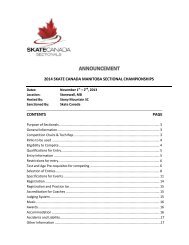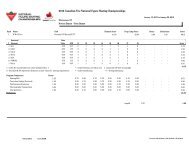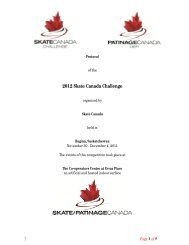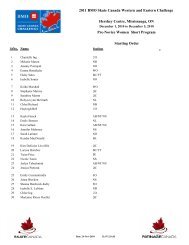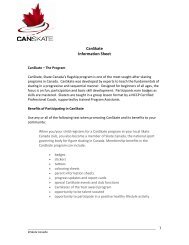LONG-TERM ATHLETE DEVELOPMENT - Skate Canada
LONG-TERM ATHLETE DEVELOPMENT - Skate Canada
LONG-TERM ATHLETE DEVELOPMENT - Skate Canada
You also want an ePaper? Increase the reach of your titles
YUMPU automatically turns print PDFs into web optimized ePapers that Google loves.
On-Ice Training<br />
On and off-ice training needs to relate to the specific phase of the yearly training plan. 865 Sheord Adaptations Road, Ottawa, should Ontario be made K1J 1H9<br />
according to an athlete’s/team’s circumstances. Phone 613.747.1007 The quality I Toll of Free work 1.888.747.2372 is far more I important Fax 613.748.5718 than I the Toll Free quantity Fax 1.877.211.2372 of work.<br />
Rest and recovery must be allowed to maximize training and to prevent injuries, fatigue and/or illness.<br />
Singles Session length: • 45 to 60 minutes<br />
• 3 sessions/day<br />
• 2 technical sessions (including program runthroughs<br />
during competitive phase)<br />
• 1 session on stroking, edges/turns, spins,<br />
choreography, etc.<br />
L o n g - Te r m A t h l e t e D e v e l o p m e n t<br />
Days/week • 5 days/week<br />
Weeks/year • 48 weeks/year<br />
Pair Session length • 45 to 60 minutes<br />
• 3 or 4 sessions/day<br />
• 2 sessions for pair skating<br />
• 1 session for jumps and spins<br />
• 1 session on stroking, edges/turns, spins,<br />
choreography, etc.<br />
Days/week • 5 days/week<br />
Weeks/year • 48 weeks/year<br />
Ice Dance Session length • 45 to 60 minutes<br />
• 3 sessions/day<br />
• 1 session to include stroking/edge/turn work<br />
Off–Ice Training<br />
Days/week: • 5 or 6 days/week<br />
Weeks/year: • 48 weeks/year<br />
All athletes should be participating in 10 to 14 hours of off-ice training each week, for 48 weeks of the year. In<br />
general, off-ice training needs to have the same commitment as on-ice training and needs to include short, medium<br />
and long-term goals. Specific work done off-ice must reflect the principles of periodization and take into account the<br />
age, growth and development of the athlete. Furthermore, at this level off-ice programs should be very sport-specific<br />
and based on the individual needs and fitness test results of the athlete.<br />
Ballet/dance classes should be incorporated into the training plan for all disciplines due to the positive crossover<br />
effect with skating. Athletes will ideally participate in two to five ballet classes per week, depending on need and<br />
discipline. Strength and conditioning classes are also critical at this stage and should be scheduled five days per<br />
week. Off-ice jumping classes should be continued for singles and pair skaters and incorporated into off-ice warm-up<br />
sessions. Pair skaters need to be performing lifts off the ice every day. Ice dancers must incorporate flexibility classes<br />
and dance classes different from ballet (e.g. ballroom, contemporary, lyrical, jazz, hip hop, Latin, etc.) All disciplines<br />
would benefit from acting or theatre classes.<br />
49<br />
L E A R N T O W I N / L I V E T O W I N



